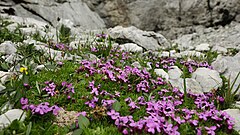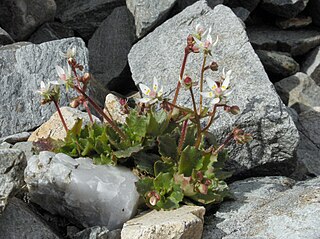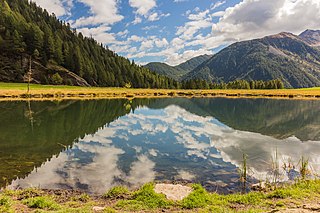An Arctic–alpine taxon is one whose natural distribution includes the Arctic and more southerly mountain ranges, particularly the Alps. [1] The presence of identical or similar taxa in both the tundra of the far north, and high mountain ranges much further south is testament to the similar environmental conditions found in the two locations. Arctic–alpine plants, for instance, must be adapted to the low temperatures, extremes of temperature, strong winds and short growing season; they are therefore typically low-growing and often form mats or cushions to reduce water loss through evapotranspiration. [2]
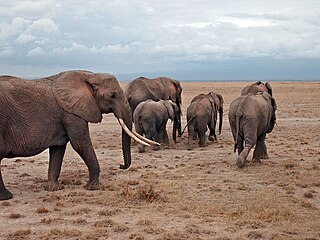
In biology, a taxon is a group of one or more populations of an organism or organisms seen by taxonomists to form a unit. Although neither is required, a taxon is usually known by a particular name and given a particular ranking, especially if and when it is accepted or becomes established. It is not uncommon, however, for taxonomists to remain at odds over what belongs to a taxon and the criteria used for inclusion. If a taxon is given a formal scientific name, its use is then governed by one of the nomenclature codes specifying which scientific name is correct for a particular grouping.
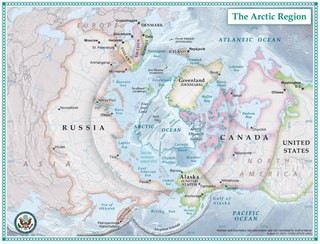
The Arctic is a polar region located at the northernmost part of Earth. The Arctic consists of the Arctic Ocean, adjacent seas, and parts of Alaska, Finland, Greenland (Denmark), Iceland, Northern Canada, Norway, Russia and Sweden. Land within the Arctic region has seasonally varying snow and ice cover, with predominantly treeless permafrost -containing tundra. Arctic seas contain seasonal sea ice in many places.
It is often assumed that an organism which currently has an Arctic–alpine distribution was, during colder periods of the Earth's history (such as during the Pleistocene glaciations), widespread across the area between the Arctic and the Alps. This is known from pollen records to be true for Dryas octopetala , for instance. In other cases, the disjunct distribution may be the result of long-distance dispersal.

The history of Earth concerns the development of planet Earth from its formation to the present day. Nearly all branches of natural science have contributed to understanding of the main events of Earth's past, characterized by constant geological change and biological evolution.
The Pleistocene is the geological epoch which lasted from about 2,588,000 to 11,700 years ago, spanning the world's most recent period of repeated glaciations. The end of the Pleistocene corresponds with the end of the last glacial period and also with the end of the Paleolithic age used in archaeology.

Pollen is a fine to coarse powdery substance comprising pollen grains which are male microgametophytes of seed plants, which produce male gametes. Pollen grains have a hard coat made of sporopollenin that protects the gametophytes during the process of their movement from the stamens to the pistil of flowering plants, or from the male cone to the female cone of coniferous plants. If pollen lands on a compatible pistil or female cone, it germinates, producing a pollen tube that transfers the sperm to the ovule containing the female gametophyte. Individual pollen grains are small enough to require magnification to see detail. The study of pollen is called palynology and is highly useful in paleoecology, paleontology, archaeology, and forensics.
Examples of Arctic–alpine plants include:
- Arabis alpina [1]
- Betula nana [3]
- Draba incana [3]
- Dryas octopetala [3] [4]
- Gagea serotina (syn. Lloydia serotina) [5]
- Loiseleuria procumbens [6]
- Micranthes stellaris [7]
- Oxyria digyna [3]
- Ranunculus glacialis [1]
- Salix herbacea [3]
- Saussurea alpina [3]
- Saxifraga oppositifolia [3]
- Silene acaulis [8]
- Thalictrum alpinum [3]
- Veronica alpina [1]
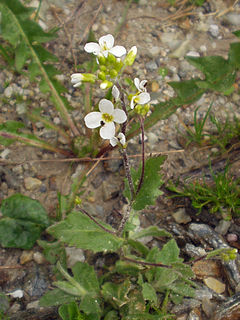
Arabis alpina is a flowering plant in the family Brassicaceae, native to mountainous areas of Europe, North and East Africa, Central and Eastern Asia and parts of North America. In the British Isles, it is only known to occur in a few locations in the Cuillin Ridge of the Isle of Skye. It inhabits damp gravels and screes, often over limestone.
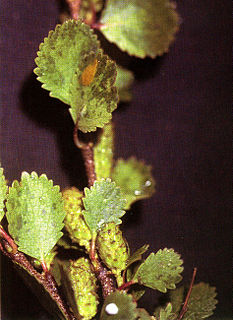
Betula nana, the dwarf birch, is a species of birch in the family Betulaceae, found mainly in the tundra of the Arctic region.
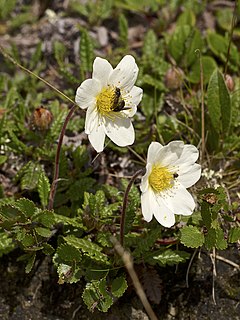
Dryas octopetala is an Arctic–alpine flowering plant in the family Rosaceae. It is a small prostrate evergreen subshrub forming large colonies. The specific epithet octopetala derives from the Greek octo (eight) and petalon (petal), referring to the eight petals of the flower, an unusual number in the Rosaceae, where five is the normal number. However, flowers with up to 16 petals also occur naturally.



